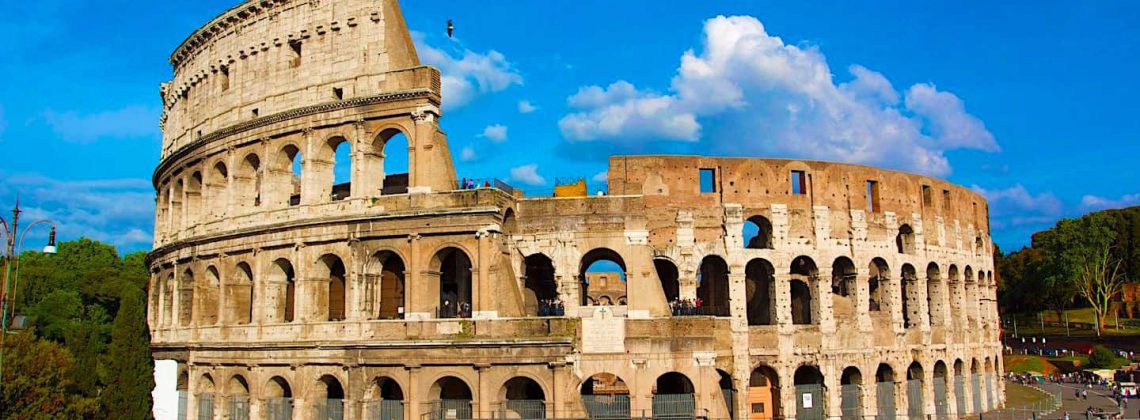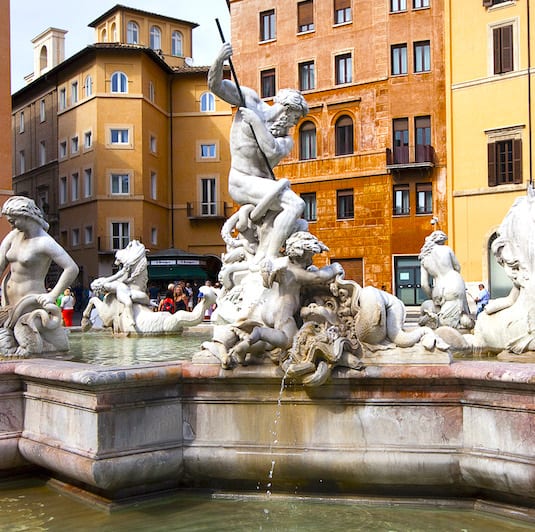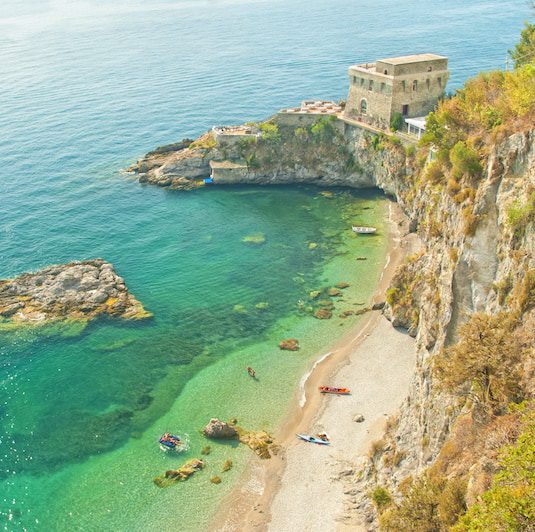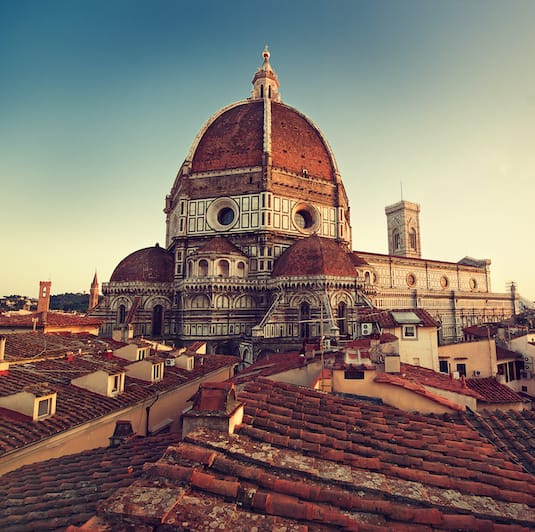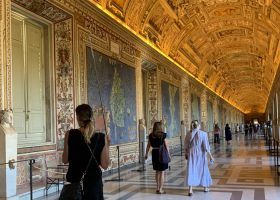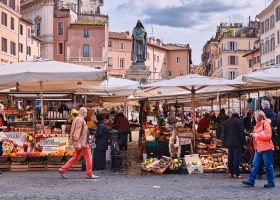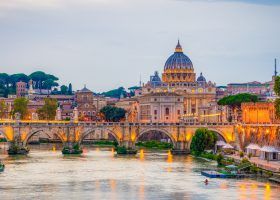When in Rome, you must visit the Colosseum. But did you know there are loads more things to do and see nearby? The area around this iconic structure is brimming with history, and we’ve created this list to help you map out the top things to do near the Colosseum.
Pro Tip: Planning can be tough, but it’s easier to organize your trip when you have all your resources in one place. Create a browser folder and bookmark this post along with our dedicated guide to planning your visit to Rome, where you’ll find everything you need. Also, check out our article on the best Colosseum tours.
What To Do and See Near the Colosseum
The Colosseum is undoubtedly one of Rome’s main attractions. It sits in a landscape steeped in history, so it will come as no surprise that around this iconic structure there are plenty of other great things to see and do near the Colosseum.
Once you’ve explored this list, use the toggle menu below to check out Rome’s other famous attractions.
Not ready to book a tour? See why a Colosseum tour is worth it.
12. The Palatine Hill
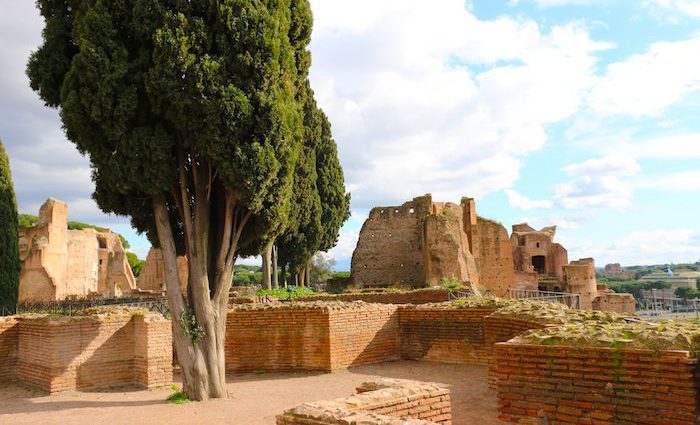
This is one of my favorite sites to visit near the Colosseum. The archeological complex is so big that you can find yourself alone among the trees and magnificent ruins. If you have a few hours to spare while in Rome, I highly recommend you make your way up the hill.
The Seven Hills of Rome
This is one of the seven founding hills of Rome. Actually, it’s the first hill, according to the legend of the founding of Rome. As the story goes, a shepard found Romulus and Remus at the base of the Palatine hill. Ironically, it is also where Romulus is said to have killed Remus.
Prime Real Estate
During the Republican era of the Roman Empire, this is where some of the highest statesmen had their homes—including Cicero himself. This area would have been prime real estate at the time, as the Palatine hill overlooks the Roman Forum, which was downtown Rome back in the day.
With the arrival of the empire, the Palatine Hill was drastically changed. The first emperor Augustus had a small, humble abode on these hills, as did Tiberius and Caligula. Compare it to 50 years later and the results are shocking. In contrast, the emperor Domitian built a massive palace that basically took up the entire hill. Imagine your palace was so big it took up an entire hill!
Today you can visit the palace area and its private arena. For more in-depth list with descriptions, check out the top things to see on Palatine Hill. While you’re there, be sure to visit these main areas of interest:
- Circus Maximus Balcony
- Casa di Livia
- Claudian Aqueduct
- The First settlements
- Balcony overlooking the Roman Forum
Address: Palatine Hill
11. St. Peter’s Chains
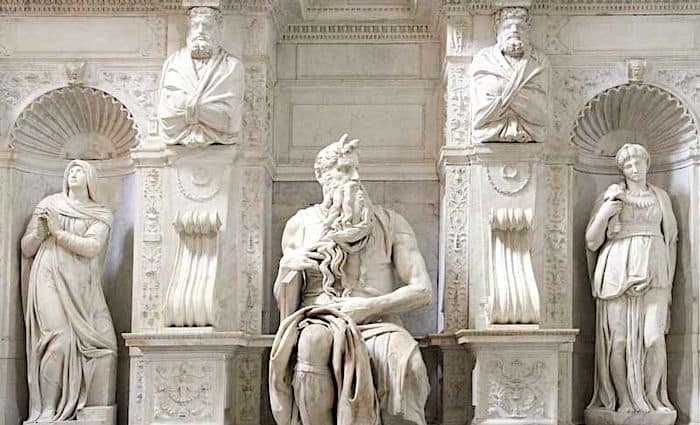
St. Peter in Chains is a small church about a seven-minute walk from the Colosseum. From the outside, it’s very unassuming, but walk in and you’ll realize you’ve discovered a hidden gem.
The Story
In a story in the apocryphal Acts of Peter, the famous phrase Domine Quo Vadis arises, which means, “Lord where are you going?” in Latin. According to the story, St. Peter was a prisoner in the city of Rome, and an angel comes and liberates him by breaking his chains. You can see these chains in the St. Peter in Chains church.
Michelangelo’s Statue of Moses
This church is also quite famous because it houses an amazing artwork by Michelangelo—the statue of Moses. It was to be a part of a gigantic tomb for Pope Julius II (Pontiff 1503-1513). Originally, the pope commissioned Michelangelo to carve 100 statues for his tomb. This work would have taken Michelangelo his entire life, which you can imagine must have made him happy because his true passion was to sculpt.
Unfortunately, as the story goes, Bramante, who was upset with Michelangelo over an earlier slight, suggested to the Pope that Michelangelo should paint the ceiling instead, even though he was not a painter. Julius agreed, and Michelangelo begrudgingly signed the contract to paint the ceiling.
Ironically, Michelangelo was not happy about the commission and supposedly even tried to run away from Rome! The original design was of the twelve apostles, but after Michelangelo objected, Julius put the design in the Master’s hands and the rest is history.
In the end, the only piece that was completed for the tomb was the statue of Moses. I have to say that it is one of the most beautiful statues I have ever seen.
Address: Piazza di San Pietro in Vincoli, 4/a
Popular Rome Tours
Not ready to book a tour? Check out our best Rome tours to take and why.
10. Basilica San Clemente
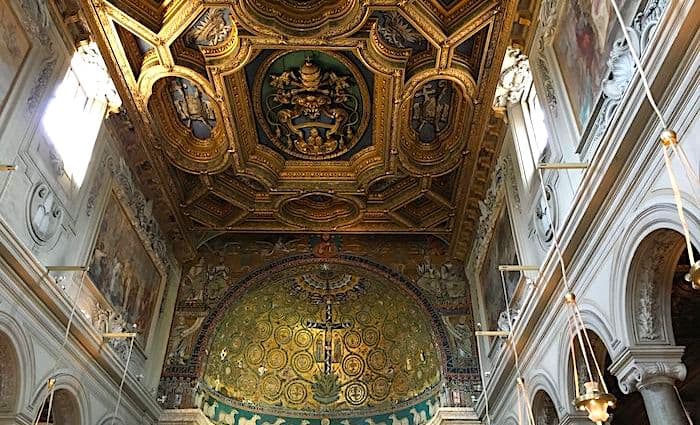
This is one of the most fascinating churches you’ll ever visit. You can visit three different levels dating from three different eras, starting from the 12th century and working your way back to the first century! People have nicknamed this church The Lasagna Church!
The Twelfth Century
As you enter the church, you’ll get a feeling for what a church was like in the middle ages in Rome. As you work your way inside, you’ll notice the rich gold leaf decorating the ceiling and an eclectic mix of marble and granite columns surrounding you. The columns are not uniform, because during the Middle Ages, laborers would reuse elements from various pagan temples. Beggars can’t be choosers!
If you’re a history nerd, you’ll appreciate the Schola Cantorum (choir) in the middle of the church. This was an area blocked off right in the middle of the church where the monks would sing. While a staple of Medieval churches, at my current count, there are only three churches left in Rome with this feature, so it’s something special.
The Eighth Century
After viewing this church from the 12th century, head underground to visit the earlier church from the eighth century, which was on the same spot. At this point, you are looking at an early Middle Ages church. It’s at this time that many of the church’s traditions and rituals took effect, especially in the artistic form.
For example, it is at this time that Jesus started to be portrayed with long hair, a beard, and a sorrowful look on his face (Paleo-Christian depictions which are much different, but that’s for another article).
The First Century
As if that wasn’t exciting enough to see, you can go down another level. At this point, you’ll be 60 feet below ground and have been transported to first-century Rome. You’ll see various rooms of what was believed to be a warehouse.
However, the most exciting area to view is the Mithraeum. This was a temple dedicated to the god Mithras, who was a type of sun god originating in Persia. The worship of Mithras was very popular with Roman soldiers who imported the deity back to Rome.
After visiting the church you will understand why people have given it the nickname The Lasagna Church!
Address: Via Labicana, 95
9. The Arch of Constantine
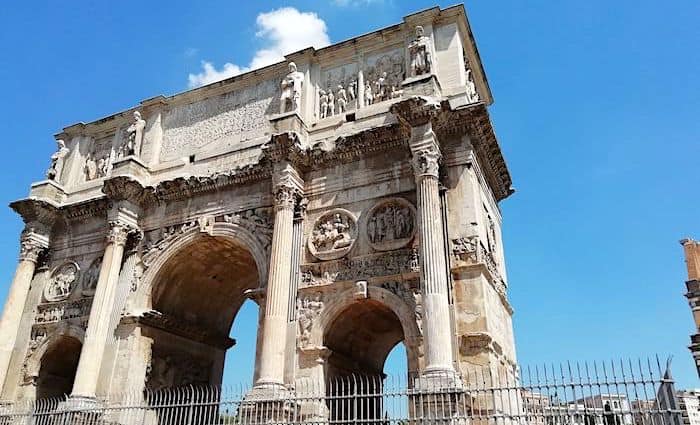
Flavius Valerius Constantinus, or Constantine the Great to most of us, was the first Christian Emperor of Rome. A triumphant arch was built and dedicated to him for his victory over Maxentius at the Battle of Milvian Bridge in A.D. 312. It’s an epic arch right in front of the Colosseum.
It sits in the Piazza del Colosseo, adjacent to the massive amphitheater, and took about two years to construct—which is record speed! The architect took some creative liberties by borrowing from some of the statues of nearby arches, temples, and structures to adorn Constantine’s arch.
It is the largest Roman arch and one of only three remaining arches in Rome. There were 36 triumphant arches by the fourth century A.D., just three of which have survived.
Address: Via di San Gregorio
8. Domus Aurea
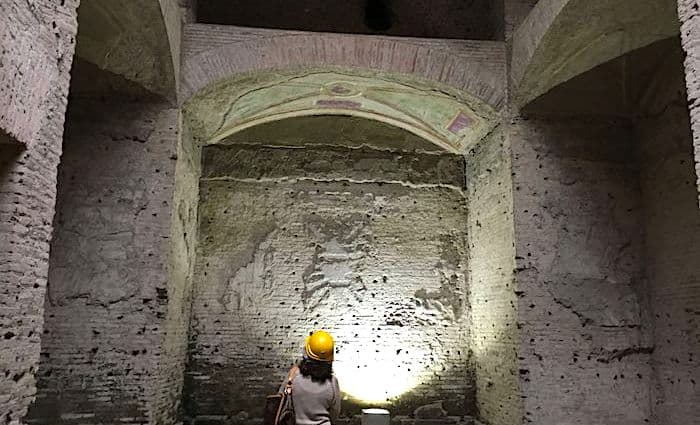
Domus Aurea translates to the House of Gold and was a great sprawling palace built by Emperor Nero. He built it across the area affected by the great fire of A.D. 64, which burnt down the valley between the Palatine, Esquiline, and Caelian Hills.
This is why Nero was famously blamed for causing the fire. Historians speculate that his golden compound was between 100 and 300 acres large in the center of Rome. Much of the compound was dismantled after Nero’s death by one emperor after another. Vespasian most famously removed a massive lake Nero had built to construct the Colosseum.
To get an idea of its opulence you first have to understand that he built an artificial lake in the area where today you would find the Colosseum. Around that lake was a portico of marble columns a mile long. This was a level of opulence and power without limits.
Address: Via della Domus Aurea
7. Mamertine Prison
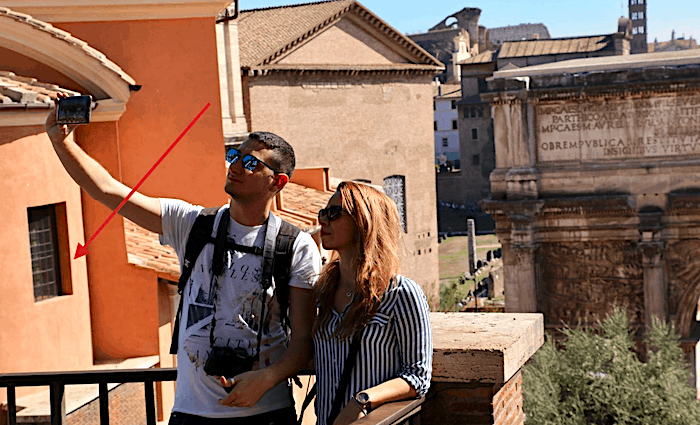
Just outside the north facing exit of the Forum, you’ll find the Mamertine Prison. It’s not actually inside the structure, so make sure you are ready to leave as you won’t be allowed reentry. The prison was said to have been built as early as the seventh century B.C. and was originally referred to as the Tullianum.
According to Christian Dogma, St. Peter was imprisoned here prior to his execution on the cross upside down. The prison was not intended for long-term incarceration, but merely a holding place prior to a trial and, eventually, execution. It was close to the Forum and Capitoline Hill, which made it accessible.
Peter was not the only prisoner of mention to be held here. Jugurtha, king of Numidia, was held in the Mamertine Prison for a short stay and possibly died inside. Vercingetorix, a chieftain from Gaul and nemesis of Julius Caesar who unsuccessfully attempted to unite Gaul against the Romans, also died here.
Most generals and high-profile leaders were pardoned after the war with the Romans, which was part of their process of getting nations to capitulate. There were some cases of extreme hatred, where Romans would be more demeaning to high-ranking opponents. The Mamertine prison was a foul enough place to seek that revenge. Also, if you wanted to display your human spoils of war, the Palatine Hill was a short walk away.
Address: Clivo Argentario, 1
6. Teatro Marcello
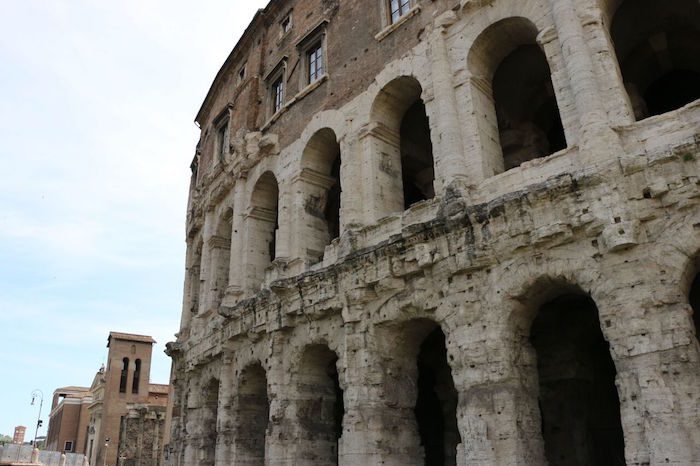
Many people mistake this structure for the Colosseum when they first visit Rome. It does look similar, but they actually built this theater before the Colosseum. However, unlike the Colosseum, you can only visit the outside of this cool ancient theater.
Once holding up to 20,000 spectators, the main entertainment here was theater and dramatics. To this day, if you happen to be here in the summertime, you can attend a classical music concert outside. What better way to spend an evening than by dreamily staring up at a 2,000-year-old monument as you listen to Beethoven?
The Orsinis, a noble Italian family, currently own the theater. One of the oldest bloodlines in Rome, this family actually has rights to and lives inside a property older than the Colosseum!
Address: Via del Teatro di Marcello
5. The Base of the Colossal Statue of Nero
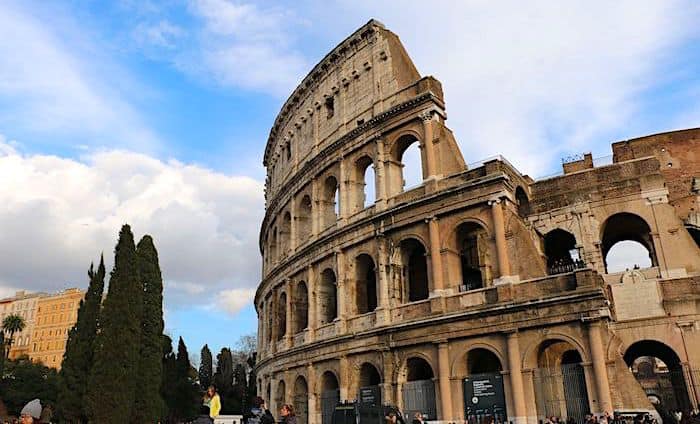
Right across from the Colosseum metro station and in front of the Colosseum itself is the base of the Colossal Statue of Nero. It isn’t much to look at today, but an important element to pass by on your way in. You’ll see a plaque reading “Area Del Basamento del Colosseo di Nerone.”
The Colossal Statue of Nero was a massive structure that measured, including the base, 106.5 Roman feet, according to Pliny the Elder. That would be about 99 feet (30.3 meters) in today’s measurements. It was built in the likeness of Nero, at least his face, until after his death when it was modified to the likeness of the sun god Sol.
You have to imagine that this statue was almost the size of the Statue of Liberty, only 10 or so feet shorter. Built and constructed without any of the machinery used to construct our Lady Liberty in the late industrial revolution.
A great example is that the statue was moved after Nero’s death to right outside the Colosseum, and ancient writers said it took some 40 elephants to transport the structure. The last mention of it in history was in the late fourth century before it vanished into thin air. Today, all we have is a portion of the base with trees growing out of it. A great place to take a load off and enjoy the shade.
Address: Piazza del Colosseo, 1
Top Colosseum Tours
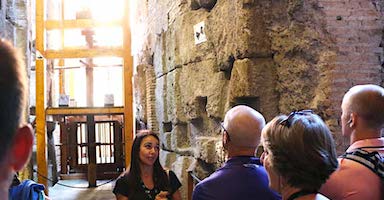
Best Seller
Colosseum Underground Tour with Roman Forum and Palatine Hill
Only 2% of visitors to the Colosseum are able to see the Underground, making tours a rare, exclusive experience. Our tours give you access to the Underground, Arena Floor, and first and second tiers—areas most people never see. Skip the line and enjoy priority access, guided by an expert who brings the Colosseum’s rich history to life. These spots sell out quickly, so don’t wait—secure your place now for this unforgettable opportunity.
See Prices
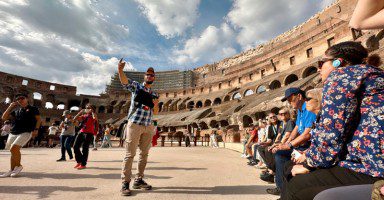
Customer Favorite
Special Access Colosseum Arena Floor Tour Through the Gladiator’s Gate
Reaching the Colosseum’s Arena Floor is no easy feat; tickets sell out quickly, leaving most visitors stuck in crowded corridors with limited views. With us, bypass the lines and enter through the Gladiator’s Gate to stand on the Arena Floor, giving you a front-row view of Rome’s nearly 2,000-year-old symbol of power and glory. With your friendly guide, uncover the Colosseum’s brutal past, then continue to the Roman Forum and Palatine Hill to explore the epicenter of ancient Roman life.
See Prices
Not ready to book a tour? Find out why a Colosseum tour is worth it.
4. Ludus Magnus
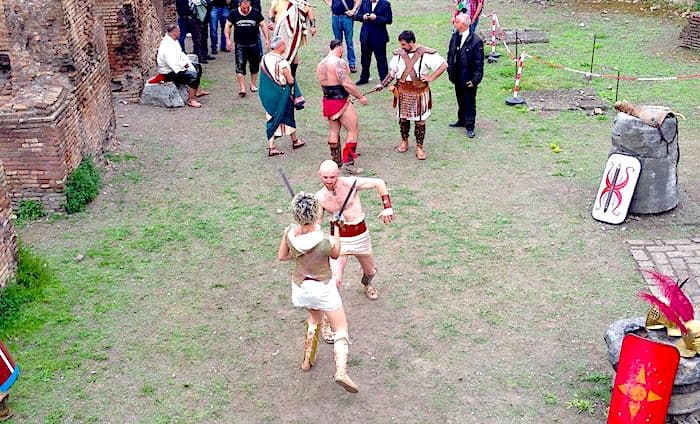
Just across from the Colosseum on Via di San Giovanni in Laterano are the remains of the Ludus Magnus—the closest and greatest gladiator training school in the empire. It has many cells for slaves and even an underground tunnel directly connected to the Colosseum.
The Ludus was built by Emperor Domitian. Just after the Colosseum was finished in A.D. 82 (with a soft opening in A.D. 80), they must have realized there were some supply chain issues with great fighters, so Domitian decided to take it upon himself to rectify the situation.
The school underwent renovations and improvements, but it was more or less used for over 200 years. Gladiators came from across the empire to train, as free persons or slaves, in what was the Harvard of gladiator schools—the Ludus Magnus.
The word ludi could be used to refer to the games and training all the same. Once you entered a ludus, your primary skillset would be chosen and you’d be trained by a lanista. The word gladiator was one specific type of fighter that fought with a short sword known as the gladius. This was popularized by the movie “Gladiator” starring Russel Crow, which is possibly the best movie ever produced.
Address: Via di S. Giovanni in Laterano
3. The Roman Forum
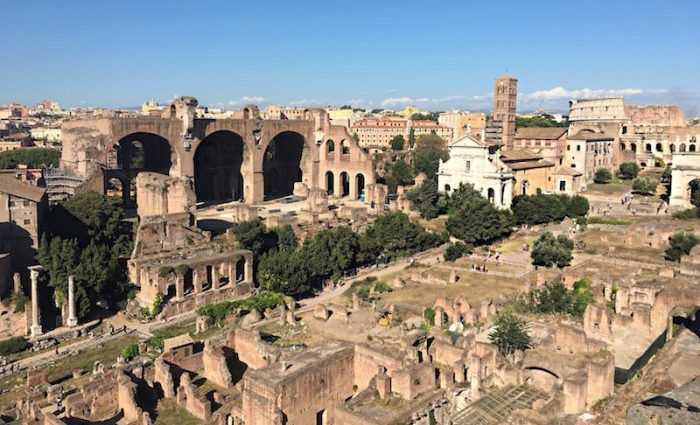
The Beginning
The Roman Forum was downtown Rome 2,000 years ago. Originally, it was a market, which was transformed little by little into a space full of temples, administrative buildings, and basilicas (courthouses, not churches).
As the legend goes, this swampy area was once a neutral no-mans-land for the various tribes who lived in the surrounding hills. When they needed to meet up, they would go into the forum and discuss serious matters. Today, we also go into forums to discuss things, so we owe this word, as well as many others, to the Ancient Romans.
Daily Life and Special Occasions
Imagine you were a senator in Ancient Rome: A large part of your day would be spent in the Forum. In the morning, you would arrive at the Forum and meet with some friends to discuss the day’s matters. Then, you would head to the Senate house to go over matters of government. After that, you’d head over to one of the basilicas to hear some of the ongoing court cases. Finally, at the end of the day, you would go to a temple to pray before heading home.
Another important feature of the Forum were the triumphal arches inside. When Romans had a military victory, they loved to show it off with massive military parades. These huge processions would wind their way around the city and go under these massive triumphal arches. Early on, these would have been made of wood, but over time they were replaced with ones made of stone.
While you could easily spend a few hours in the Roman Forum, here are some of the top sites to see:
- Arch of Titus
- Basilica of Constantine
- The Temple of Romulus
- Temple of Antoninus and Faustina
- Temple of the Vestas & Eternal Flame of Rome
- The Temple of Julius Caesar
- The Curia (Senate House)
- Arch of Septimius Severus
- Temple of Saturn
Check out more top things to see at the Roman Forum.
Address: Via della Salara Vecchia, 5/6
2. The Arena Floor of the Colosseum
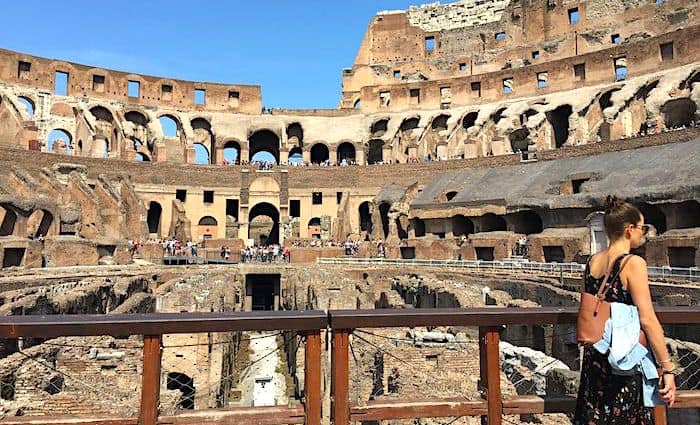
This is one of my favorite parts of the Colosseum. Imagine being able to walk in the same area where ferocious animals and bold gladiators walked 2,000 years ago? When you go on to the arena floor, not only is it a once-in-a-lifetime experience, but you’ll be able to grasp the enormous size of the Colosseum as you stand in the middle of it.
The arena floor is one of the exclusive access areas that the Colosseum offers. It is quite difficult to get tickets to enter, but luckily you can come with us! We offer a 2.5-hour tour that includes exclusive access to the Arena floor and includes the Roman Forum and Palatine Hill.
When you are out on the arena floor, you get a 360-degree view of the enormity and power of Ancient Rome. Imagine you were just a simple farmer taken as a slave by the Romans, and then for punishment, you were sent into the arena to be destroyed by exotic predators. It would be intimidating to say the least. The last thing you would hear were the thunderous screams of more than 50,000 people as you meet your death.
Address: Piazza del Colosseo, 1
1. The Underground (Dungeons) of the Colosseum
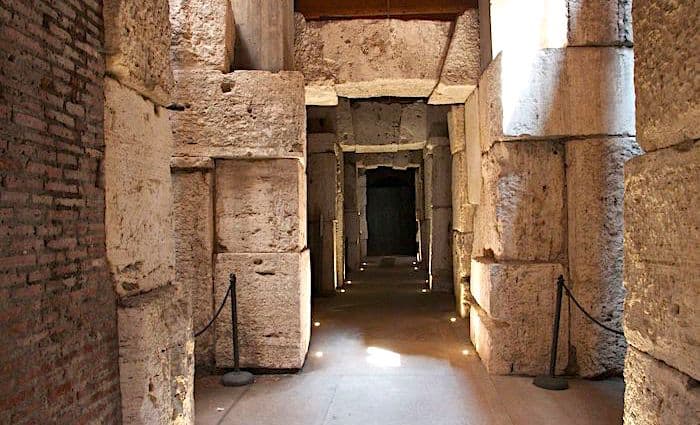
Underneath the Colosseum, there’s a complex labyrinth of tunnels once used by gladiators and event organizers. This is by far the most popular subject that visitors want to hear about and that was before they even opened the area for tours.
It’s really one of the defining features of the Colosseum. What other stadium or arena has trap doors that allow fighters or animals to elevate or pop out of? The underground or hypogeum was a very complex area. It had as many as 36 trap doors and areas to store an entire show’s worth of entertainment.
Without a doubt, it’s the most exclusive area of the Colosseum. General admission won’t get you there, but we have a Colosseum Underground tour that takes you there.
Address: Piazza del Colosseo, 1
Not ready to book a tour? See why a Colosseum tour is worth it.
Here’s Where To Stay in Italy’s Most Popular Destinations
Rome, Florence, Venice, Amalfi Coast, and Capri

